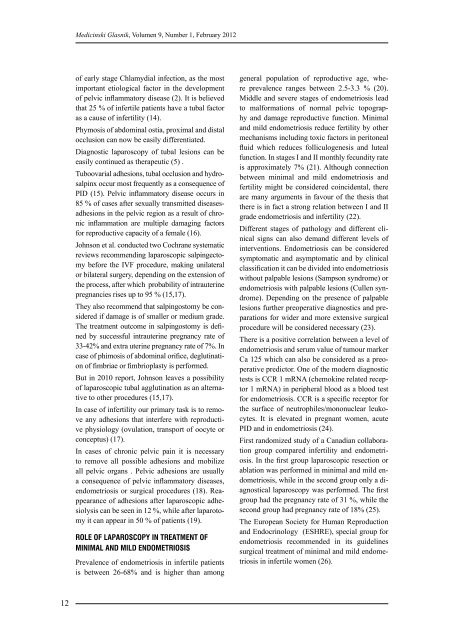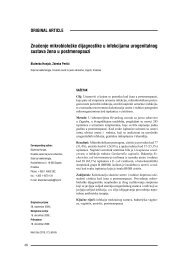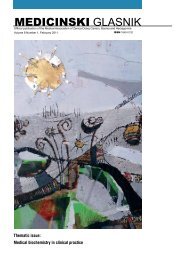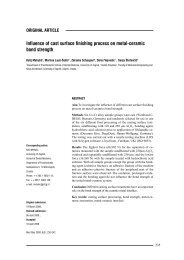MEDICINSKI GLASNIK
MEDICINSKI GLASNIK
MEDICINSKI GLASNIK
You also want an ePaper? Increase the reach of your titles
YUMPU automatically turns print PDFs into web optimized ePapers that Google loves.
12<br />
Medicinski Glasnik, Volumen 9, Number 1, February 2012<br />
of early stage Chlamydial infection, as the most<br />
important etiological factor in the development<br />
of pelvic inflammatory disease (2). It is believed<br />
that 25 % of infertile patients have a tubal factor<br />
as a cause of infertility (14).<br />
Phymosis of abdominal ostia, proximal and distal<br />
occlusion can now be easily differentiated.<br />
Diagnostic laparoscopy of tubal lesions can be<br />
easily continued as therapeutic (5) .<br />
Tuboovarial adhesions, tubal occlusion and hydrosalpinx<br />
occur most frequently as a consequence of<br />
PID (15). Pelvic inflammatory disease occurs in<br />
85 % of cases after sexually transmitted diseasesadhesions<br />
in the pelvic region as a result of chronic<br />
inflammation are multiple damaging factors<br />
for reproductive capacity of a female (16).<br />
Johnson et al. conducted two Cochrane systematic<br />
reviews recommending laparoscopic salpingectomy<br />
before the IVF procedure, making unilateral<br />
or bilateral surgery, depending on the extension of<br />
the process, after which probability of intrauterine<br />
pregnancies rises up to 95 % (15,17).<br />
They also recommend that salpingostomy be considered<br />
if damage is of smaller or medium grade.<br />
The treatment outcome in salpingostomy is defined<br />
by successful intrauterine pregnancy rate of<br />
33-42% and extra uterine pregnancy rate of 7%. In<br />
case of phimosis of abdominal orifice, deglutination<br />
of fimbriae or fimbrioplasty is performed.<br />
But in 2010 report, Johnson leaves a possibility<br />
of laparoscopic tubal agglutination as an alternative<br />
to other procedures (15,17).<br />
In case of infertility our primary task is to remove<br />
any adhesions that interfere with reproductive<br />
physiology (ovulation, transport of oocyte or<br />
conceptus) (17).<br />
In cases of chronic pelvic pain it is necessary<br />
to remove all possible adhesions and mobilize<br />
all pelvic organs . Pelvic adhesions are usually<br />
a consequence of pelvic inflammatory diseases,<br />
endometriosis or surgical procedures (18). Reappearance<br />
of adhesions after laparoscopic adhesiolysis<br />
can be seen in 12 %, while after laparotomy<br />
it can appear in 50 % of patients (19).<br />
ROLE OF LAPAROSCOPY IN TREATMENT OF<br />
MINIMAL AND MILD ENDOMETRIOSIS<br />
Prevalence of endometriosis in infertile patients<br />
is between 26-68% and is higher than among<br />
general population of reproductive age, where<br />
prevalence ranges between 2.5-3.3 % (20).<br />
Middle and severe stages of endometriosis lead<br />
to malformations of normal pelvic topography<br />
and damage reproductive function. Minimal<br />
and mild endometriosis reduce fertility by other<br />
mechanisms including toxic factors in peritoneal<br />
fluid which reduces folliculogenesis and luteal<br />
function. In stages I and II monthly fecundity rate<br />
is approximately 7% (21). Although connection<br />
between minimal and mild endometriosis and<br />
fertility might be considered coincidental, there<br />
are many arguments in favour of the thesis that<br />
there is in fact a strong relation between I and II<br />
grade endometriosis and infertility (22).<br />
Different stages of pathology and different clinical<br />
signs can also demand different levels of<br />
interventions. Endometriosis can be considered<br />
symptomatic and asymptomatic and by clinical<br />
classification it can be divided into endometriosis<br />
without palpable lesions (Sampson syndrome) or<br />
endometriosis with palpable lesions (Cullen syndrome).<br />
Depending on the presence of palpable<br />
lesions further preoperative diagnostics and preparations<br />
for wider and more extensive surgical<br />
procedure will be considered necessary (23).<br />
There is a positive correlation between a level of<br />
endometriosis and serum value of tumour marker<br />
Ca 125 which can also be considered as a preoperative<br />
predictor. One of the modern diagnostic<br />
tests is CCR 1 mRNA (chemokine related receptor<br />
1 mRNA) in peripheral blood as a blood test<br />
for endometriosis. CCR is a specific receptor for<br />
the surface of neutrophiles/mononuclear leukocytes.<br />
It is elevated in pregnant women, acute<br />
PID and in endometriosis (24).<br />
First randomized study of a Canadian collaboration<br />
group compared infertility and endometriosis.<br />
In the first group laparoscopic resection or<br />
ablation was performed in minimal and mild endometriosis,<br />
while in the second group only a diagnostical<br />
laparoscopy was performed. The first<br />
group had the pregnancy rate of 31 %, while the<br />
second group had pregnancy rate of 18% (25).<br />
The European Society for Human Reproduction<br />
and Endocrinology (ESHRE), special group for<br />
endometriosis recommended in its guidelines<br />
surgical treatment of minimal and mild endometriosis<br />
in infertile women (26).












